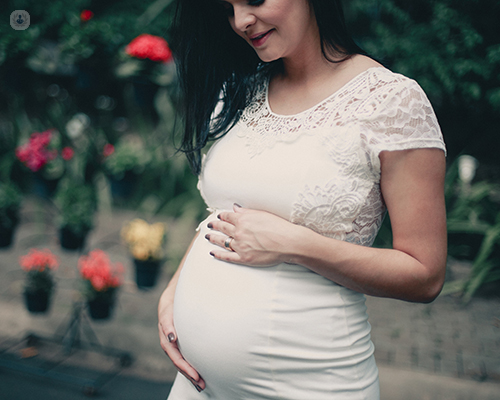Birth planning for first-time mothers: An expert guide
Written in association with:To help expectant mothers to prepare for a safe and calm labour and delivery, it is important to create a thorough birth plan in coordination with a specialist. For first-time mothers in particular, understanding all of the available delivery and pain relief options, amongst other areas, is key. In this detailed guide, highly respected consultant in obstetrics and maternal and foetal medicine Dr Spyros Bakalis shares his expert insight on the most important aspects of birth planning and offers detailed reassurance and advice for first-time mothers on how to ensure their delivery is as comfortable and safe as possible.

What is a birth plan?
During a first pregnancy, it’s common to feel anxiety about the timing of your labour and exactly how your delivery will take place. A birth plan allows you to prepare ahead according to your aims for your delivery. The birth plan should be flexible and personalised to the mother’s wants and needs but it’s also important to have a full understanding of how plans can change during labour itself.
Your birth plan will include a lot of detailed information, including:
- Where you are going to deliver
- Who will be with you
- Your mode of delivery, i.e., caesarean section or normal vaginal delivery
- Any special procedures or birthing equipment you would like
- Your thoughts and feelings around emergency caesarean section and instrumental deliveries
- How the baby will be monitored during delivery
- Hour positions for birth
- How active you want to be during labour
- Pain relief
Finally, your birth plan will also include plans for post-birth around breastfeeding and skin-to-skin care to establish how you would like this to be done in the best-case scenario.
What should you research before preparing your birth plan?
Before preparing your birth plan, you should have a look at the NHS birth plan worksheet or alternatively, you can obtain one from my secretary. The first step is to read through this information and have a think about what you do or do not want.
I would strongly advise being cautious about accepting help or advice from friends and relatives when making your birth plan as the whole point is to ensure your birth plan is personalised to your own experience, rather than being based on those of other people.
When considering your birth plan, you can have a look at different types of delivery, i.e. caesarean section or normal vaginal delivery, as well as pain relief options and various types of birthing equipment which you may find useful. You should also look into how having continuous or intermittent monitoring of your baby during delivery impacts both your labour and the noise around your labour.

Who can help you prepare your birth plan?
Your birth plan can be prepared by yourself and your partner and ideally, with either your consultant obstetrician or midwife who will be able to take you through the various aspects of the birth plan. NCT (a national charity for pregnancy, birth and early parenthood) classes can sometimes be helpful for women when preparing their birth plan but you can also go back to your consultant or midwife to discuss any further details so that you are completely happy with all aspects of your plan.
What should your birth plan include?
There are multiple aspects of a birth plan that one should take into consideration. The first and foremost is where you would like to give birth, either at home, in a midwifery clinic or a hospital. Each of these has pros and cons and you have to decide which you feel is the best and safest option for you.
The next part of the birth plan is to decide who will be with you at the birth. Often partners want to be present but sometimes sisters, mothers or other friends are requested by women and this is more than reasonable. You should keep people around you that will help you feel safe and secure and will speak up for you if there are any concerns.
You should then think about how you are going to deliver, be it by caesarean section or normal vaginal delivery, and also consider your thoughts on having an instrumental delivery, i.e. the use of ventouse or forceps and/or an episiotomy. You should take into consideration any special equipment you would like, such as bean bags, mats, special bars to help you move around, and any special positions you would like such as a birthing pool or other such features.

Monitoring the baby is an important aspect of labour and the two most commonly used methods are continuous assessment, where the baby is listened to throughout the labour, and intermittent monitoring, where the baby’s heartbeat is listened to at five-minute intervals to ensure it remains steady. Each of these approaches has pros and cons, and you have to decide which you feel is best and most safe for your baby.
You may also want to discuss your activity levels during labour. I strongly recommend being active as this allows your body to keep moving which can also help with pain relief. Positions of labour can also be discussed though these are often best found when you are in labour, as you can see which is the most comfortable at the time.
Additionally, there should be a discussion about pain relief. Some women like to try with no pain relief at all, while others opt for a massage, acupuncture, hot water, gas and air or - the highest level of all types of pain relief - an epidural. Each has pros and cons and varies in its pain-relieving effects but this tends to vary from woman to woman.
Finally, you may wish to have a discussion about skin-to-skin contact, breastfeeding and vitamin K for your baby.
What advice would you give to first-time mothers preparing their birth plan?
The advice I would give to first-time mothers preparing their birth plan is to be open-minded and relaxed about the discussion. I would advise them to have more than one discussion with their consultant or midwife, to share any doubts they may have and not to feel uncomfortable about any specific or unusual questions. Other than that, the discussion should be had in a relaxed atmosphere, to allow both mother and partner to ask any questions that pertain to themselves.
What post-natal planning should be included in the birth plan?
Postnatal planning differs depending on the type of delivery and this means that the amount of time you will need to spend in hospital following delivery will vary. Usually, for a caesarean section this is two days and for normal delivery is up to twenty-four hours.
Areas you may wish to discuss are cord clamping, skin-to-skin contact, breastfeeding, vitamin K or any other specific plans you have for your baby. Most teams can be flexible with what they provide you and the key is to ensure you are satisfied with the care given to your baby.
Dr Spyros Bakalis is one of the UK’s leading consultants in obstetrics and maternal and foetal medicine. If you would like to schedule a consultation with him to discuss your birth plan, you can do so by visiting his Top Doctors profile.


